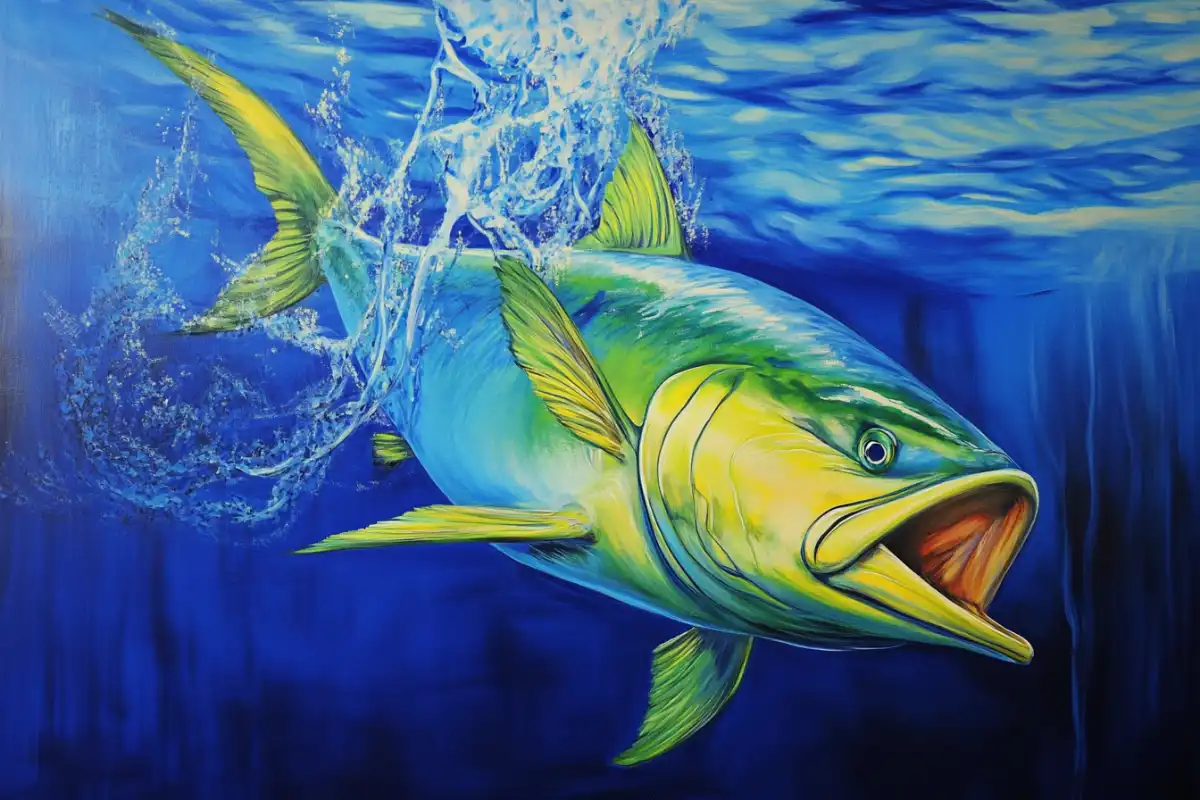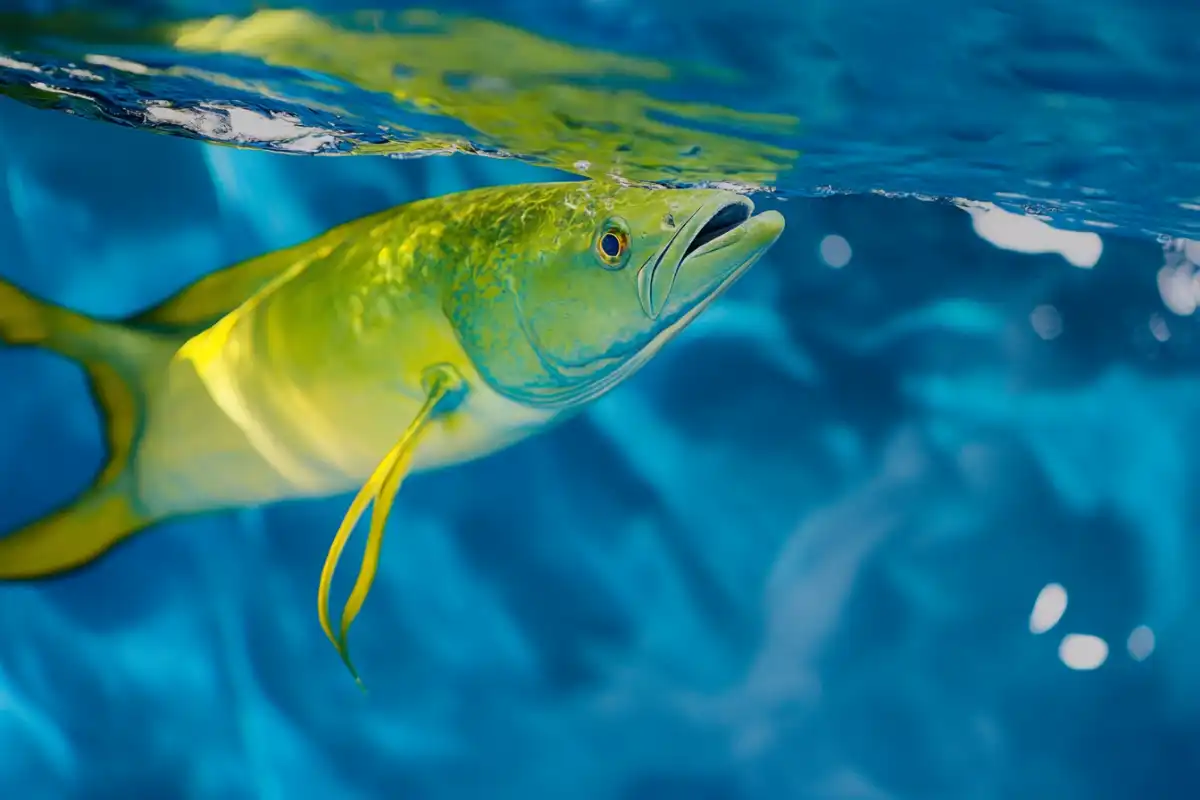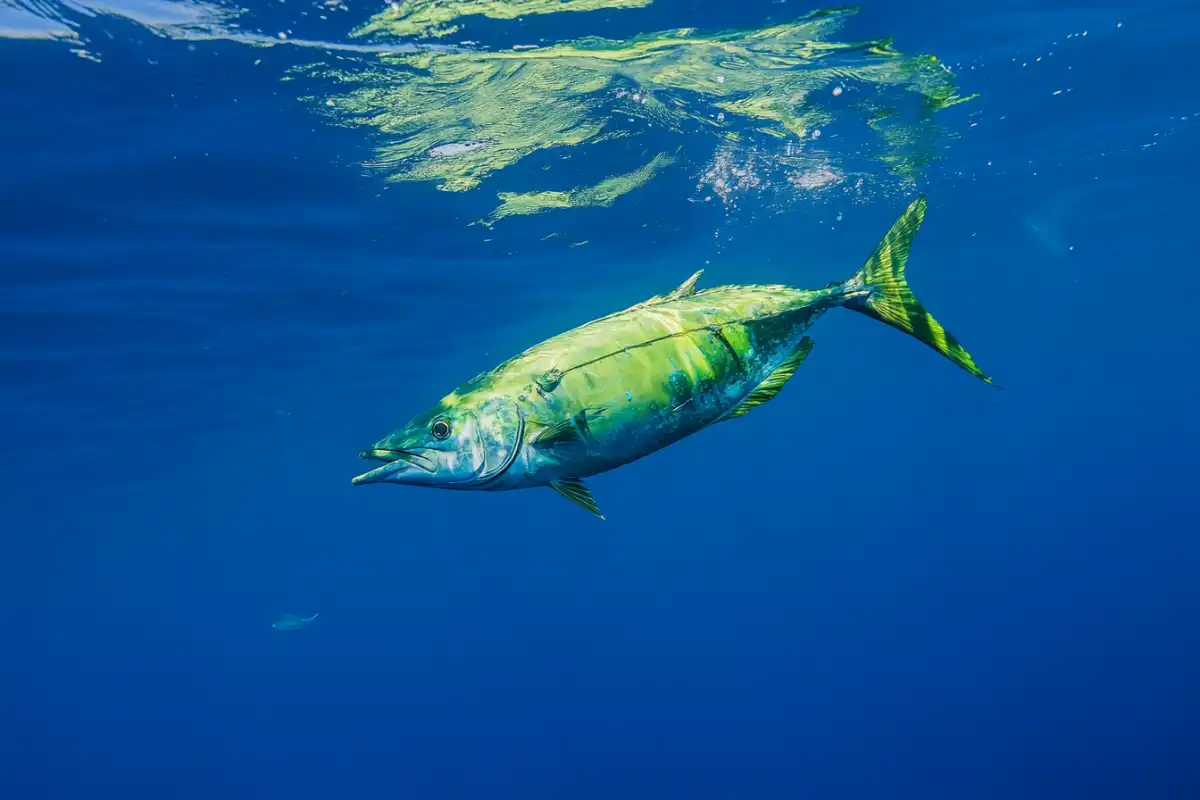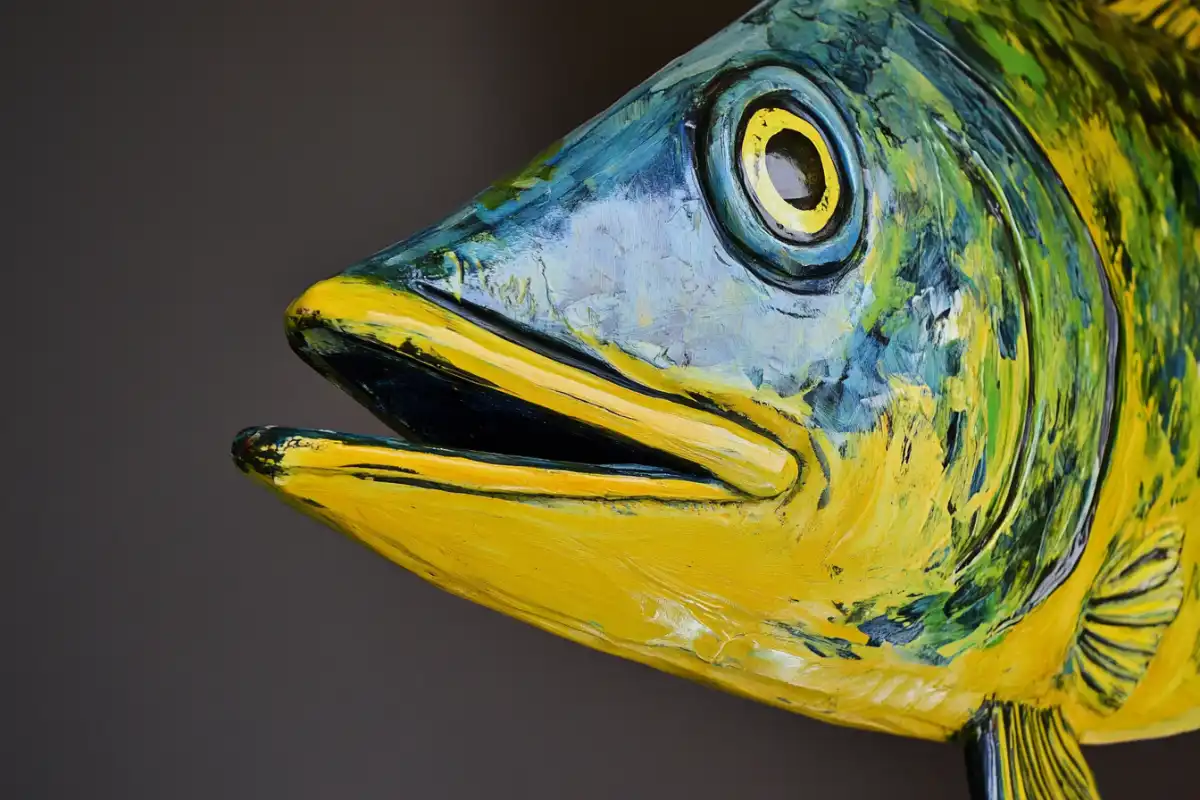Why is mahi mahi on the avoid list?
Mahi mahi, once a favorite in many kitchens, is now on the avoid list for those who care about the planet. This fish is known for its vibrant color and delicious taste. But, its environmental impact has raised serious concerns.
Overfishing and harmful fishing methods have hurt mahi mahi populations. These practices also harm the marine ecosystems where they live. High mercury levels in mahi mahi pose health risks to those who eat it.

- Mahi mahi has been placed on the avoid list due to sustainability concerns
- Overfishing and unsustainable fishing practices have impacted mahi mahi populations
- The environmental impact of mahi mahi fishing on marine ecosystems is significant
- High mercury levels in mahi mahi are also a concern for human health
- Sustainable seafood alternatives are available for eco-conscious consumers
Understanding Mahi Mahi
Mahi mahi, also known as dolphinfish or dorado, is a favorite seafood choice. It’s known for its vibrant color and delicious taste. This fish is also packed with nutrients, making it popular worldwide.
What is Mahi Mahi?
Mahi mahi, or Coryphaena hippurus, is a fast-swimming fish found in warm waters. It has a bright blue-green and yellow color that changes after it’s caught. These fish can grow up to 5 feet long and are known for their acrobatic leaps.
Nutritional Value and Culinary Uses
Mahi mahi is a great source of protein, with 20 grams in every 3.5-ounce serving. It’s also full of vitamins and minerals like vitamin B12, selenium, and phosphorus. This fish is low in fat and calories, making it a favorite for those watching their diet.
In cooking, mahi mahi’s firm texture and mild taste make it versatile. It can be grilled, baked, sautéed, or used in stews and curries. Chefs love it because it can be prepared in many ways, enhancing its flavor.

“Mahi mahi is a truly remarkable fish, with a unique appearance and a flavor profile that pairs beautifully with a wide range of ingredients and cooking techniques.”
Environmental Concerns with Mahi Mahi
Mahi mahi is a favorite seafood choice, but it faces growing environmental worries. These worries have put it on seafood avoid lists. The main issues are overfishing and the harm caused by fishing methods to marine ecosystems.
The mahi mahi environmental impact is a big worry. This fish is easy to overfish because it grows fast and breeds a lot. This makes it a target for commercial fishing, which can harm the ocean’s balance and threaten mahi mahi’s future.
Also, the sustainability issues with mahi mahi get worse because of how it’s caught. Longlines and fish aggregating devices (FADs) are used, hurting sea turtles, sharks, and other fish. These methods harm mahi mahi and the ocean’s health and diversity.
“Mahi mahi’s fast growth rate and prolific breeding habits make it an attractive target for commercial fisheries, leading to the risk of unsustainable harvesting practices.”
As people learn more about the harm their seafood choices cause, there’s a push for better mahi mahi farming and fishing. It’s key to tackle these mahi mahi environmental impact and sustainability issues with mahi mahi to keep this fish healthy and available for the future.

Overfishing and Unsustainable Practices
Mahi mahi, also known as dolphinfish, is very popular. This has led to overfishing and bad fishing methods. The demand is high, but there’s not enough regulation. This has hurt mahi mahi populations worldwide.
Impact on Marine Ecosystems
Fishing for mahi mahi is aggressive and hurts marine ecosystems. Longline fishing, with lines that stretch for miles, is common. It catches mahi mahi and other sea creatures, like turtles and sharks, causing bycatch.
Fish aggregating devices (FADs) are also used. They attract mahi mahi and other sea life. This leads to mahi mahi overfishing and harm to marine life.
- Longline fishing methods lead to high levels of bycatch, affecting the delicate balance of marine ecosystems.
- The use of fish aggregating devices (FADs) concentrates mahi mahi but also attracts other marine species, leading to entanglement and unsustainable mahi mahi fishing.
- Overfishing and unsustainable mahi mahi fishing practices have caused the depletion of mahi mahi populations in many regions.
“The high demand for mahi mahi, combined with lax regulations and ineffective management, has pushed this species to the brink of collapse in some areas.”
Overfishing and unsustainable mahi mahi fishing harm marine ecosystems. As consumers, we must choose sustainable seafood. This helps protect mahi mahi and the oceans they live in.
Mahi Mahi and Mercury Levels
Mahi mahi is a popular seafood choice, but concerns about mercury are growing. Mercury is a heavy metal that can harm health, especially for pregnant women and children. It can also affect people with certain health issues.
Research shows mahi mahi, or dolphinfish, have more mercury than other fish. This is because they eat smaller fish that have already absorbed mercury. This mercury builds up in mahi mahi.
The health concerns with mahi mahi come from its high mercury levels. Eating mahi mahi with high mahi mahi mercury content can harm the brain and cause developmental delays. These risks are higher for vulnerable groups.
“Mahi mahi is a tasty fish, but it’s important to be aware of the potential mercury risks, especially for those who consume it regularly,” says marine biologist Dr. Emma Wilkins.
The FDA and health groups have set guidelines for eating mahi mahi. They suggest limiting its intake or choosing fish with less mercury. These guidelines, along with environmental worries, make some people avoid mahi mahi.
Knowing about the health concerns with mahi mahi and its mahi mahi mercury content helps us make better seafood choices. This way, we can protect our health and the oceans.
Sustainable Seafood Alternatives
Many eco-conscious consumers are looking for seafood that’s better for the planet. Luckily, there are many fish options that are both tasty and good for the environment. Let’s look at some of the best choices that can replace mahi mahi.
Eco-Friendly Fish Options
Wild-caught Alaska pollock is a great choice for those who care about the planet. It’s plentiful and managed well. Another good option is farmed rainbow trout, which is raised in a way that’s kind to the environment.
If you’re up for trying something new, Pacific cod and Alaskan salmon are excellent choices. These fish are caught using methods that protect the sea and its creatures.
“Choosing sustainable seafood alternatives is a simple way to reduce your environmental footprint and support healthy marine ecosystems.”
By choosing these sustainable seafood options, you can enjoy tasty fish while helping our oceans stay healthy.
- Wild-caught Alaska pollock
- Farmed rainbow trout
- Pacific cod
- Alaskan salmon
Mahi Mahi on Seafood Watch Lists
Reputable organizations like Seafood Watch guide us in choosing sustainable seafood. They’ve put mahi mahi on the “avoid” list. This highlights the environmental concerns of this popular fish.
Seafood Watch, run by the Monterey Bay Aquarium, checks seafood’s sustainability. They look at the fishery’s health, the ecosystem’s impact, and management practices. The latest ratings for mahi mahi are worrying. It’s listed as “Avoid” in many places because of overfishing and bycatch issues.
“Mahi mahi is often caught using methods that can harm other marine life, such as longlines and gillnets. This can lead to the unintentional capture of sea turtles, sharks, and other vulnerable species, threatening the overall health of the ecosystem.”
The Marine Stewardship Council (MSC) also has concerns. They haven’t certified any mahi mahi fisheries as sustainable. This adds to the “avoid” list for many.
As seafood sustainability ratings for mahi mahi show, we need to be careful. Making smart choices when buying and eating mahi mahi helps. It supports a healthier ocean and a more responsible food system.
Making Informed Choices
As people become more aware of mahi mahi’s environmental impact, it’s key to know how to pick the right seafood. By checking where seafood comes from and reading labels, you can find the most eco-friendly choices. This helps you make smart buys.
Evaluating Seafood Sources
Choosing sustainable seafood starts with the source. Look for seafood with certifications from groups like the Marine Stewardship Council (MSC) or the Aquaculture Stewardship Council (ASC). These marks mean the seafood was caught or farmed in a green way.
Also, learn about the fishing or farming methods used. Stay away from seafood caught with harmful methods like bottom trawling. Choose seafood caught or farmed in ways that protect the sea and its creatures.
To help you decide, check out the Seafood Watch program from the Monterey Bay Aquarium or the Good Fish Guide from the Marine Conservation Society. These guides give detailed info on seafood’s sustainability and environmental effects.
“Making informed choices about seafood is a crucial step in supporting sustainable fisheries and protecting our oceans.” – Sustainable Seafood Coalition
By carefully choosing your seafood and understanding its impact, you help our oceans stay healthy. You also make sure you’re enjoying your seafood in a way that’s good for the planet.
Conclusion
The reasons mahi mahi is on the avoid list are complex. Overfishing and unsustainable practices harm the environment. Mercury levels also pose health risks. Yet, by choosing sustainable seafood, we can help.
Understanding the mahi mahi dilemma helps us make better choices. Our choices affect the health of our oceans and marine life. By picking sustainable seafood, we support a healthier future.
Avoiding mahi mahi shows the seafood industry’s big challenges. But, we can make a difference. By staying informed and making smart choices, we help create a better seafood system for all.
FAQ
What is mahi mahi?
Mahi mahi, also known as dolphinfish, is a favorite seafood choice. It’s found in tropical and subtropical waters worldwide. It’s a large, colorful fish often seen on menus.
What are the nutritional benefits of mahi mahi?
Mahi mahi is lean and flaky, packed with protein, vitamins, and minerals. It’s a great source of omega-3 fatty acids, good for the heart and brain. It’s also easy to cook in many tasty ways.
Why is mahi mahi on the avoid list?
Mahi mahi is on some seafood avoid lists due to environmental worries. These worries include overfishing and the harm of fishing methods on marine life. The sustainability of this species is also a concern.
What are the specific environmental concerns with mahi mahi?
The main issues with mahi mahi are overfishing and the harm of fishing methods. These methods can damage marine habitats and disrupt ecosystems. The lack of sustainable practices in the industry also affects mahi mahi populations.
What are the health concerns with mahi mahi?
Mahi mahi has high mercury levels, which can be a health risk. This is especially true for pregnant women and young children. Eating too much mahi mahi can lead to health problems.
What are some sustainable seafood alternatives to mahi mahi?
For those avoiding mahi mahi, there are eco-friendly fish options. Wild-caught salmon, mackerel, sardines, and some tuna are good alternatives. They are considered more sustainable and better for the environment.
How can I evaluate the sustainability of my seafood choices?
To make responsible seafood choices, check the source and sustainability of your fish. Look for certifications from organizations like the Marine Stewardship Council (MSC) or the Aquaculture Stewardship Council (ASC). Research the fishing methods and practices used.
